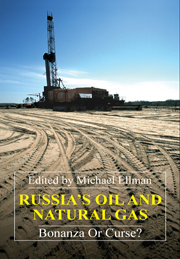Book contents
- Frontmatter
- Contents
- List of Tables and Figures
- Preface
- A Overview
- B Financial Flows
- C Economic Policy Issues
- 5 Sustaining Growth in a Hydrocarbon-based Economy
- 6 The Road to Spontaneous Diversification
- 7 Economic Growth and the Mobilization Model
- 8 The Importance of Geography
- D Political Issues
- List of Contributors
- Index
- More Titles in the Series
6 - The Road to Spontaneous Diversification
from C - Economic Policy Issues
Published online by Cambridge University Press: 05 March 2012
- Frontmatter
- Contents
- List of Tables and Figures
- Preface
- A Overview
- B Financial Flows
- C Economic Policy Issues
- 5 Sustaining Growth in a Hydrocarbon-based Economy
- 6 The Road to Spontaneous Diversification
- 7 Economic Growth and the Mobilization Model
- 8 The Importance of Geography
- D Political Issues
- List of Contributors
- Index
- More Titles in the Series
Summary
Background
Russia's economy has made a clear and remarkably speedy recovery since the doldrums of 1998, having averaged growth of 6.8 per cent per year. As a result, in 1999–2005 the Russian economy grew by 57 per cent. In spite of the fact that the rate of growth slowed in mid-2004 and early 2005, largely due to a negative change in economic policy, growth numbers remained relatively strong (if not as high as they could be).
So, Russia continues to demonstrate a healthier macroeconomic performance than many other countries. Equally important, is the fact that Russia financed this growth mainly from its own sources, i.e., without any massive inflow of FDI or external borrowing (albeit the latter did increase substantially in 2003 and has kept growing since then). Russia for decades was a country that exported capital. Capital flight was not a phenomenon only of the 1990s. It also took place in earlier decades, although for different reasons and through different channels. From the macroeconomic point of view, continuous support of communist regimes all over the world can be treated as capital flight legitimized by the government. It also means that once Russia starts attracting more FDI, which will finance particular projects, growth rates may be high even in the absence of domestic financing. That said, the well-known task of doubling the GDP in 10 years, as was suggested by the Russian president in 2003, in principle looks achievable.
- Type
- Chapter
- Information
- Russia's Oil and Natural GasBonanza or Curse?, pp. 127 - 150Publisher: Anthem PressPrint publication year: 2006
- 1
- Cited by



